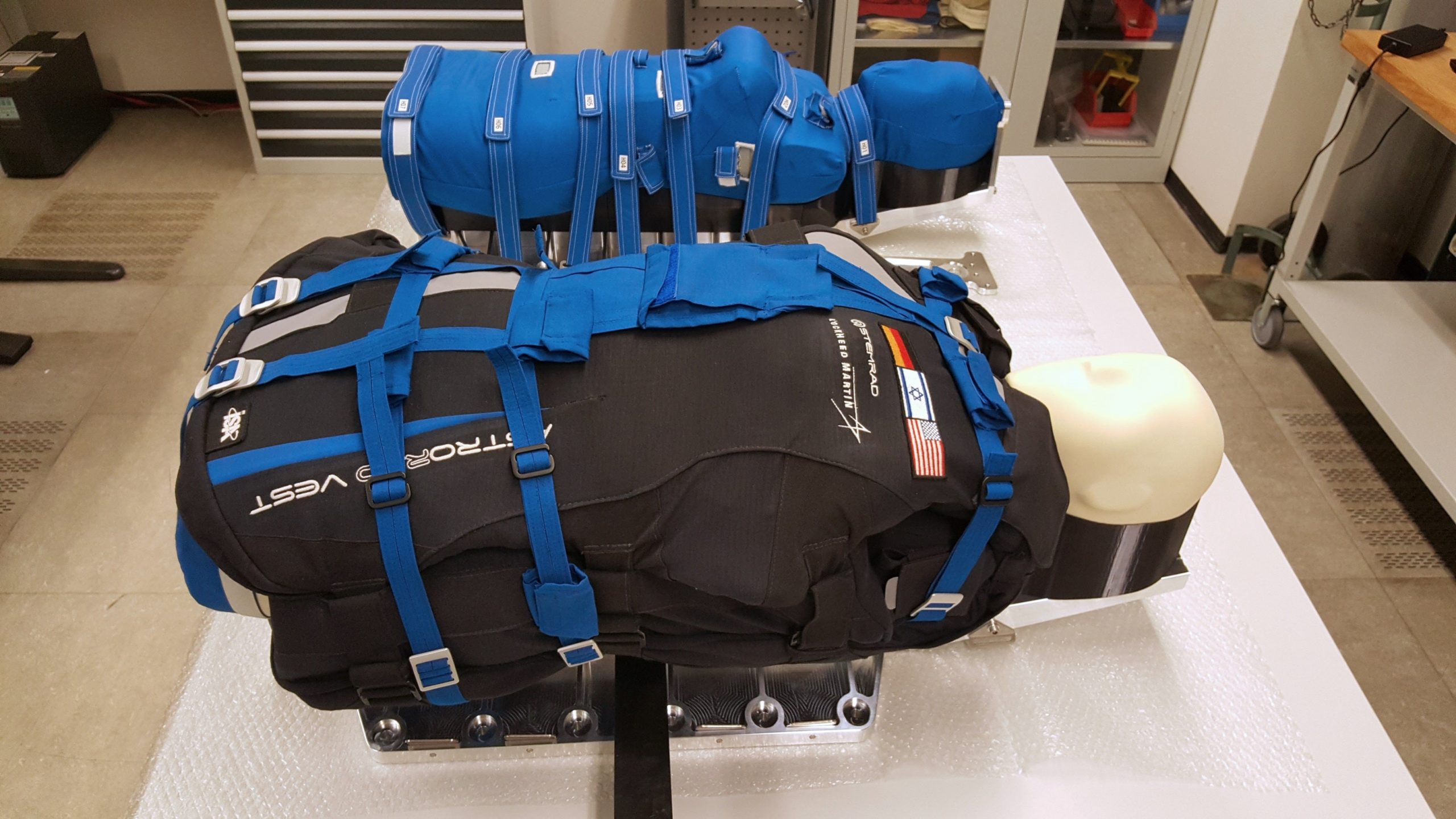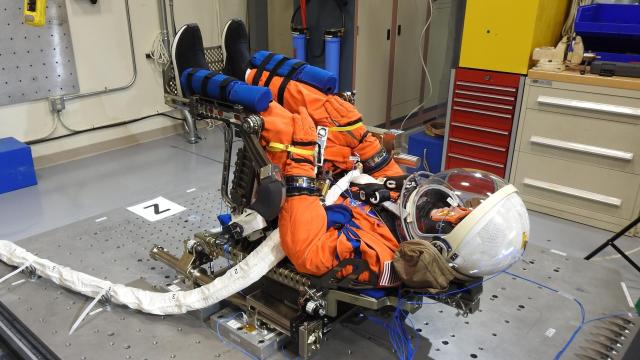Should all go according to plan, NASA’s new Space Launch System megarocket will finally leave Earth this November, in a journey that will take an Orion capsule to the Moon and back. No human will fly on this inaugural Artemis mission, but a soon-to-be-named manakin will make the trip along with a pair of simulated torsos.
NASA’s Space Launch System is coming along nicely, so it’s only natural to start thinking about a crew, or at least, a stand-in for the real crew (the actual Artemis team has already been chosen, in case you’re wondering). Having flesh-and-blood humans participate in an inaugural rocket launch would be unspeakably reckless, which is why NASA is preparing a manikin for the mission.
But this ain’t your ordinary storefront mannequin, for this dummy will be fitted with two radiation sensors to record data during the Artemis I flight and will wear NASA’s next-generation flight suit, also known as the Orion suit. A pair of sensors will also be fitted to the manikin’s seat — the commander’s seat, no less — to track the spacecraft’s vibration and acceleration during the trip. The seat also features an energy dampening system, called the Crew Impact Attenuation System. This safety feature is currently going through qualification testing in anticipation of a crewed mission to the Moon.
Indeed, the first Artemis mission will pack a big punch. In addition to launching SLS for the first time, NASA will send an uncrewed Orion capsule — with all due respect to the manikin — on a 280,000-mile (450,000-kilometre) journey to the Moon and back. Were any astronauts to be on board, they would experience 2.5 times the force of gravity during the ascent and endure high radiation levels during passage through the Van Allen belts — clouds of high-energy particles located between Earth and the Moon (prior to the Apollo missions, NASA was concerned that the Van Allen Belts might actually prove fatal to the astronauts, which didn’t turn out to the the case).
The Orion spacecraft will also return to Earth’s atmosphere at speeds reaching 11 km per second (11 km/s), which will eventually be the fastest reentry ever for a crewed space capsule. The exterior of Orion will also experience temperatures reaching 5,000 degrees Fahrenheit (2,760 degrees Celsius), which will be hotter than what the spacecraft endured during its 2014 test flight.
So yeah, sending a dummy on this first flight is a smart idea, as the exercise could reveal potentially dangerous conditions for astronauts. What’s more, data collected during Artemis I “will be used for Orion crew simulations and to verify crew safety by comparing flight vibration and acceleration against pre-flight predictions, then making model refinements as necessary,” Mark Baldwin, Orion’s occupant protection specialist for Lockheed Martin, explained in a statement. Success in the mission will set the stage for Artemis II, in which the exact mission will repeat, save for the presence of an actual crew.
To be clear, the Artemis manikin is no crash test dummy, which is a separate category of human stand-in, as NASA explains:
Similar to manikins, NASA uses Anthropometric Test Devices, or “crash test dummies,” that are equipped with various instruments for other crew safety evaluations. Dummies are used in tests that drop a test version of Orion from an aircraft, with the final set of tests scheduled for later this year, to verify the Artemis II seat and suit can limit the risk of head and neck injury during the most severe acceleration environments – abort and landing. During water impact drop tests at Langley, dummies also occupied crew capsule prototypes to help engineers better understand what Orion and its crew may experience when landing in the ocean after missions to the Moon.
Artemis I will also include a pair of simulated torsos named Helga and Zohar. The pair will be strapped into the lower two seats on Orion and record radiation exposure during the mission. One torso will be used to test a radiation-shielding vest, called AstroRad, which is designed to reduce exposure.

These limbless torsos have names, but the manikin does not. At least not yet. NASA has launched a contest to name the dummy, but those of you hoping to submit Manny McManikinface will be in for a profound disappointment, as the space agency, likely in anticipation of such hijinks, has supplied a predetermined set of candidates (captions provided by NASA):
- ACE: Straightforward, practical. Stands for Artemis Crew Explorer.
- CAMPOS: Resourceful, problem-solver. A dedication to Arturo Campos, key player in bringing Apollo 13 home.
- DELOS: Nostalgic, romantic. The island where Apollo and Artemis were born, according to Greek myth.
- DUHART: Warm, welcoming. A dedication to Irene Duhart Long, chief medical officer at Kennedy Space Centre.
- MONTGOMERY: Pioneer, innovative. A dedication to Julius Montgomery, first African American to work at the Cape Canaveral Space Facility as a technical professional.
- RIGEL: Bright, inspirational. The giant superstar in the Orion constellation.
- SHACKLETON: Secretive, abundant. A crater on the Moon’s south pole and a reference to a famous Antarctic explorer.
- WARGO: Enthusiastic, passionate. A dedication to Michael Wargo, the agency’s first Chief Exploration Scientist.
Starting today, NASA will be asking people on Twitter, Facebook, and Instagram to choose between one of two names. Eventually, the naming brackets will be whittled down to two finalists, and a winner will be announced on June 28.
I’m a fan of both ACE and SHACKLETON, but MONTGOMERY is pretty cool, too. Sending Monty on a momentous mission to the Moon has a nice ring to it.
